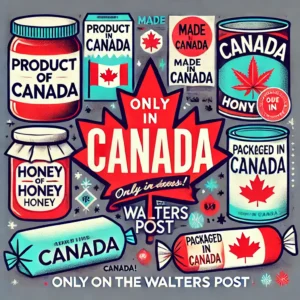Click on Image to Enlarge!
Now, I’ve been around long enough to know that words can be tricky. Companies, politicians, and marketers like to play word games, and if you’re not paying attention, you might think you’re buying something Canadian when you’re really just getting a label with a maple leaf slapped on it. So, let’s clear up the nonsense and get to the truth about these so-called “Canadian” products.
“Product of Canada” – The Real Deal
If you see “Product of Canada” on a label, that means nearly everything in that product is from right here in Canada. According to the rules, at least 98% of the ingredients and materials must come from Canada, and the product must be processed here too. That’s as close as you can get to a truly Canadian product.
Example: If you buy a jar of honey labelled “Product of Canada,” that honey came from Canadian bees, tended by Canadian beekeepers, and put in a jar right here at home. That’s the good stuff.
“Made in Canada” – A Bit of a Mixed Bag
Now, “Made in Canada” sounds good, but there’s a catch. Only 51% of the total cost of making that product has to be from Canada. That means a lot of the ingredients or materials could come from other countries, but as long as the final product is put together or processed here, they can slap “Made in Canada” on it.
Example: Let’s say you buy a loaf of bread labelled “Made in Canada.” The wheat might be from the U.S., the yeast from Europe, and the packaging from China—but as long as it’s baked and assembled here, it qualifies. So, it’s not quite as Canadian as you might think.
“Packaged in Canada” – A Sneaky One
Now, here’s where things get real tricky. “Packaged in Canada” means just that—the product was put in a box, bag, or jar here. That’s it. It says nothing about where the ingredients came from. A company could import fruit from Mexico, put it in a plastic tub in Ontario, and call it “Packaged in Canada.” Not exactly what most people would expect when they see Canada on the label.
Example: Ever seen frozen vegetables with a big Canadian flag but no clear statement on where the veggies came from? If it says “Packaged in Canada,” those peas could be from China, India, or who knows where. They were just put in a bag here. And let’s be honest—personally, I don’t care much for anything grown in China or India. I’d rather know my food came from Canadian soil, where I trust the standards and the farming practices.
Why This Matters
A lot of folks not all now a days, want to support Canadian farmers and businesses, especially with all these trade wars and economic ups and downs. But if you’re not paying attention, you might think you’re buying Canadian when you’re really not.
Here’s my advice: always read the labels closely. Look for “Product of Canada” if you want the real deal. “Made in Canada” can be fine, but keep in mind that some of the ingredients could be imported. And if it only says “Packaged in Canada,” take a moment to flip the package over and check where the ingredients actually come from. More often than not, those ingredients are sourced from elsewhere—sometimes even far from Canada. It’s a bit of a loophole, letting companies slap a Canadian label on products that don’t actually meet the standards of what we might expect from homegrown goods. So, don’t just trust the front of the package; the truth is often hidden on the back.
So yea—I’ve seen a lot of tricks in my day, and this one is right up there with the best of them. Don’t let clever marketing fool you. If you want to support Canadian businesses, make sure you know what you’re buying. Keep your money where it matters—right here at home.
Until next time—keep your minds open and your stories alive! GW

